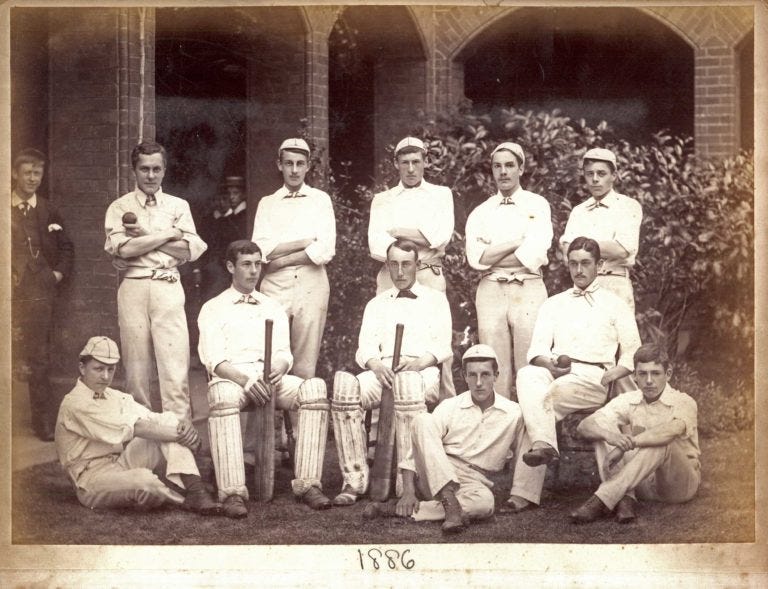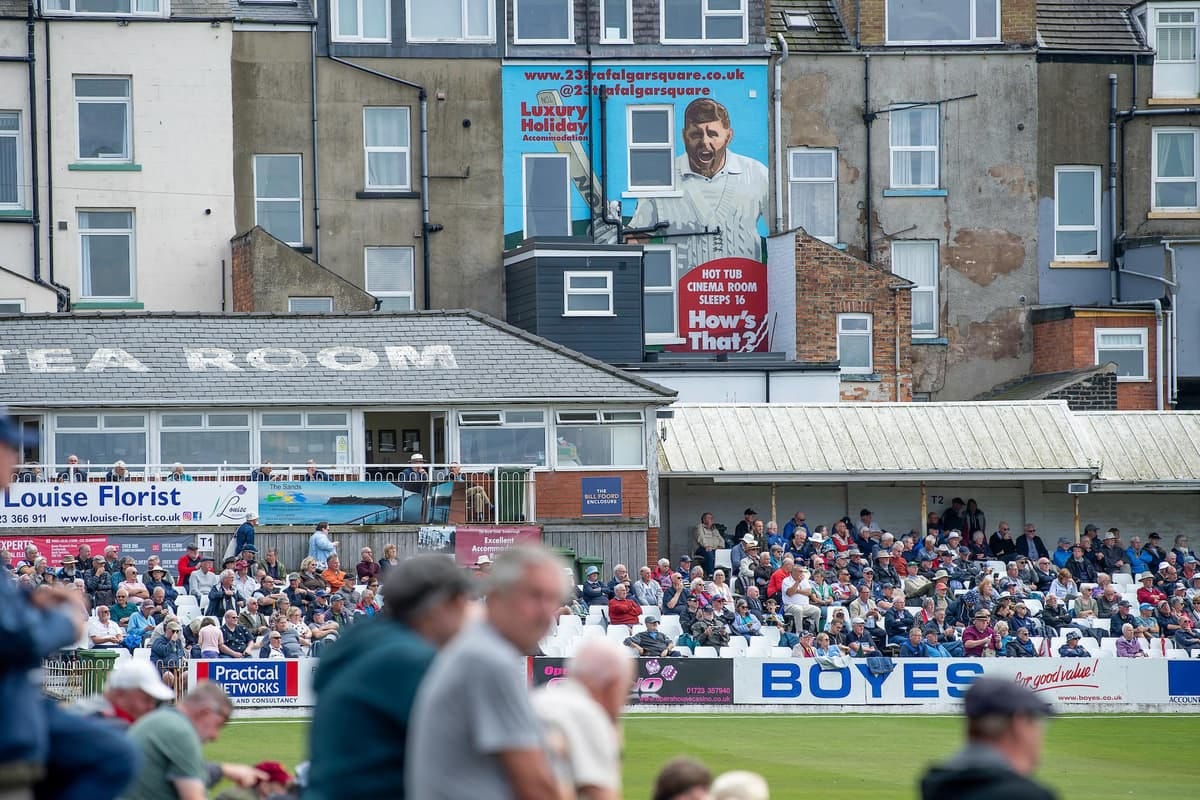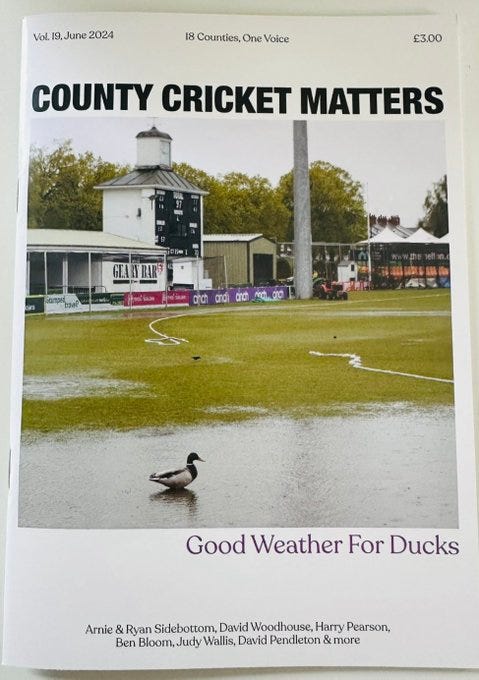A Right Royal Romp
At Scarborough Cricket Club ...
The 2023 edition of Wisden Cricketers’ Almanack carried Queen Victoria’s somewhat belated obituary, there it was stated that her grandson, Prince Christian Victor is the only member of the British Royal Family to have played first-class cricket. The game in question took place between i Zingari and the Gentlemen of England at Scarborough on 29 August 1887.
Prince Christian Victor (seated, centre), captain of Wellington College First XI in 1886 (image courtesy of Wellington College Archives).
As a life member of the North Marine Road Club, I devoured this morsel of royal trivia with a gusto normally reserved for the evening opening time at the nearby North Bay Fisheries. For I knew that there was a fading photograph of i Zingari and the Gentlemen of England in the pavilion.
As Scarborough trudged out to meet Woodhouse Grange beneath grey bank holiday skies, I raced up the pavilion stairs and outside the gents toilets, there they were, the moustachioed chaps, frozen in time, waiting patiently all these years for this moment. They looked back at me, suitably unimpressed, was that a wry smile on the lips of W.G. Grace? The date written above the photograph said 1889 … two years after the prince had strode to the wicket.
I slumped into a chair in the bar. As the gentlemen of Scarborough and Woodhouse Grange battled each other and a damp early season wicket, I decided that the old ghosts would not elude me a second time. It may have been the fading light, but I’m sure that the bowler-hatted umpire shifted his weight from one leg to another, as I made a determined exit down the pavilion steps.
A regular feature of the Scarborough Festival, meetings between i Zingari and the Gentlemen of England were, well, a bit of a slog-fest. Epitomised by co-founder of the festival, Charles ‘Buns’ Thornton, who in the 1886 match hit eight sixes, one of which sailed through an open window of a house in Trafalgar Square, narrowly missing the lady occupant. Another cleared the tall houses entirely, landing in the street, the first of only three occasions in the history of the ground that a batsman has struck a ball into Trafalgar Square.
It should be pointed out that the Trafalgar Square in question is not the somewhat better known London one, complete with pigeons and Nelson’s soaring column. Scarborough’s version comprises of tall lodging houses, they peer inquisitively into the cricket ground over the Trafalgar Square end. Scarborough’s square seems to be a celebration of the internal combustion engine. Every inch is taken up by cars, parked at angles methodically arrived at to cover every available inch of tarmac. The sun never shines on the darkened tarmac, it is in permanent shade, only briefly do gaps in the ranks appear, before a car leaps on its prey; the coveted empty spot. The triumph of the driver, the unadulterated glee, it will be the favoured, nay only, topic of conversation in the Albert public house tonight. How he ‘got in’. The square’s most notable landmark was a bloke living in an algae-covered caravan who sold off cut logs to householders. He was recently moved on, apparently the sight of him repeatedly defecating in the street was too much for passing holidaymakers.
The houses of Trafalgar Square offer an unrivalled view of the cricket ground. One guest house now has its own Jonny Bairstow mural advertising facilities such as a hot tub, cinema room and accommodation for sixteen. Owzat! it says. An interesting addition to the neighbourhood I expect. Apparently there was to be a Joe Root mural on another of the houses, but an issue with the planning permission for ‘Jonny Bairstow’ has put paid to it. There’s a hint of irony in the choice of Jonny for the mural, as he didn’t play at North Marine Road for nearly a decade. As following his 139 and 74 not out in a seven-wicket win against Worcestershire in 2015 at Scarborough saw him recalled to the England test team. Success for England, and the invention of the The Hundred competition, meant that the frolicers in the hot tub had to wait until August 2024 for a return of Jonny Bairstow to North Marine road.
It is to be hoped that the owners of the property next door don’t fancy an ‘Alex Carey’ mural …
Jonny Bairstow watches over Scarborough’s cricket ground
But back to royal romps on the field. The Gentlemen of England won the toss and elected to bat. It was clearly ‘a good toss to win’, as ‘Buns’ Thornton and W.G. Grace amassed 173 in an impressive opening stand. Thornton was first to fall, although only after plundering 107 runs in an hour and ten minutes, with all three of his sixes departing the ground. At number three Andrew Stoddart added to the carnage, scoring a quick-fire 116. However, Prince Victor did manage to catch Charles Burls, it was to be his only first-class catch, ensuring that Burls remains the sole first-class cricketer to be dismissed by a member of the royal family.
Facing a deficit of 381 i Zingari were in all sorts of trouble at 191 for 8 when the fabulously named Harry Farquhar de Paravicini walked out to join Prince Victor at the wicket. The pair evidently enjoyed themselves, as they ‘hit away vigorously’ accumulating a seventy-three run partnership before the prince had a rush of blood and was stumped for thirty-five. The innings ended shortly after and i Zingari were asked to follow on. In the second innings the prince did not trouble the scorers, but his teammates managed 308 all out. But, after all the excitement, the match fizzled out into a draw.
The match was Prince Victor’s sole first-class appearance. However, he remained an enthusiastic cricketer, appearing for i Zingari in second-class matches against Worcestershire, Ireland, and the Gentlemen of Durham. There are distant rumours of a swash-buckling 205 for the Kings Royal Rifles against Devonshire Regiment at Rawalpindi in 1893.
The army was Prince Victor’s other passion. After attending Sandhurst Military Academy, where he naturally captained the cricket team, he served under Lord Kitchener at the Battle of Omdurman in 1898. He also participated in the Second Boer War and the Relief of Ladysmith in March 1900. The prince died on 29 October 1900, not as a result of enemy action, but due to enteric fever, aged just thirty-three. He had apparently played a game of cricket the day before he was bed-bound with the fever which was to claim his life. On the orders of his grandmother Queen Victoria, he was buried at Pretoria, today the capital of the Republic of South Africa.
A version of this article was published in the March edition of County Cricket Matters. A fabulous magazine and an absolute must for all devotees of the county game in England.




